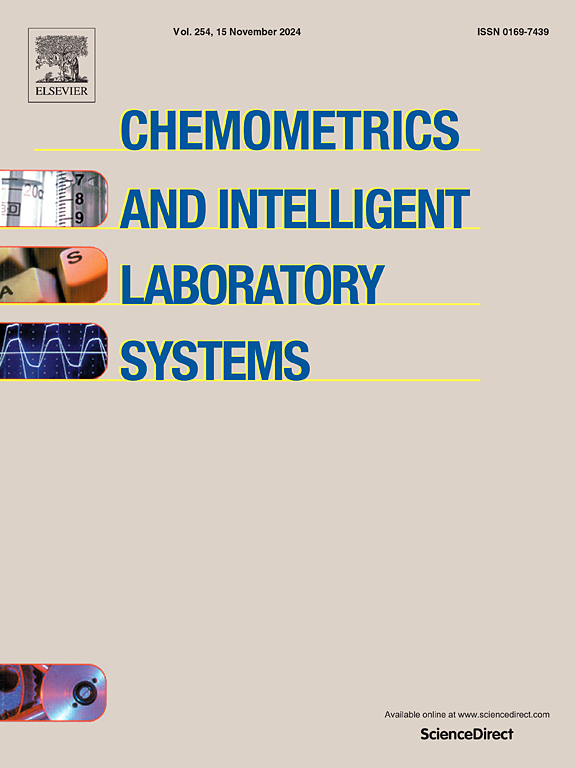An enhanced IWCARS method for measuring soil available potassium
IF 3.7
2区 化学
Q2 AUTOMATION & CONTROL SYSTEMS
Chemometrics and Intelligent Laboratory Systems
Pub Date : 2025-01-23
DOI:10.1016/j.chemolab.2025.105324
引用次数: 0
Abstract
The Competitive Adaptive Re-weighted Sampling (CARS) method, while excelling in feature extraction, encounters several challenges when processing low-quality data, including high computational complexity, intricate parameter settings, and the potential for overfitting. To address these issues, this paper introduces the IWCARS (Initial Weight and Weight, I & W) algorithm, which implements two key methodological enhancements: initial weight selection and weight update strategy. This algorithm, building upon the traditional CARS algorithm and density-based clustering, offers a supplementary tool for data feature selection by computing density and weight, and employs an adaptive model evaluation mechanism to select the most pertinent features, ultimately constructing a model with enhanced predictive capability. IWCARS optimizes model performance by dynamically adjusting the feature set, thereby improving the algorithm's prediction performance and model fit. Furthermore, the IWCARS method, in conjunction with a Partial Least Squares (PLS) model, was applied to measure soil Available Potassium (AK) content using near-infrared spectroscopy. Five pre-processing techniques were conducted on the near-infrared spectrum, with the IWCARS + PLS model constructed using first derivative data, yielding optimal results. The experimental results demonstrated that the model based on 1st Derivative + IWCARS + PLS yielded the best performance. Specifically, the model achieved RC2 of 0.9905, Rp2 of 0.9817, RMSEC of 0.8917, RMSEP of 0.9024, and RPD of 8.5176. Robustness, versatility, and transferability tests demonstrated that the proposed IWCARS algorithm, when integrated into the PLS model, achieved commendable measurement accuracy. While there are limited strategies for concurrently addressing high computational complexity, challenging parameter settings, and overfitting risks, this study aims to mitigate these concerns by reducing the computational complexity of the CARS algorithm, simplifying parameter settings, and preventing overfitting, ultimately enhancing the model's fitting accuracy, training speed, and generalization capability.
一种改进的IWCARS法测定土壤速效钾
竞争自适应重加权采样(CARS)方法虽然在特征提取方面表现出色,但在处理低质量数据时遇到了一些挑战,包括高计算复杂度,复杂的参数设置以及过度拟合的可能性。为了解决这些问题,本文引入了IWCARS (Initial Weight和Weight, I &;该算法实现了两个关键的方法改进:初始权值选择和权值更新策略。该算法在传统CARS算法和基于密度的聚类的基础上,通过计算密度和权值为数据特征选择提供补充工具,并采用自适应模型评价机制选择最相关的特征,最终构建具有增强预测能力的模型。IWCARS通过动态调整特征集来优化模型性能,从而提高算法的预测性能和模型拟合。此外,采用IWCARS方法,结合偏最小二乘(PLS)模型,利用近红外光谱技术测定土壤速效钾(AK)含量。对近红外光谱进行了5种预处理技术,利用一阶导数数据构建了IWCARS + PLS模型,得到了最优的预处理结果。实验结果表明,基于一阶导数+ IWCARS + PLS的模型性能最好。具体而言,模型的RC2为0.9905,Rp2为0.9817,RMSEC为0.8917,RMSEP为0.9024,RPD为8.5176。鲁棒性、通用性和可转移性测试表明,当集成到PLS模型中时,所提出的IWCARS算法实现了值得称赞的测量精度。同时解决高计算复杂度、具有挑战性的参数设置和过拟合风险的策略有限,本研究旨在通过降低CARS算法的计算复杂度、简化参数设置和防止过拟合来缓解这些问题,最终提高模型的拟合精度、训练速度和泛化能力。
本文章由计算机程序翻译,如有差异,请以英文原文为准。
求助全文
约1分钟内获得全文
求助全文
来源期刊
CiteScore
7.50
自引率
7.70%
发文量
169
审稿时长
3.4 months
期刊介绍:
Chemometrics and Intelligent Laboratory Systems publishes original research papers, short communications, reviews, tutorials and Original Software Publications reporting on development of novel statistical, mathematical, or computer techniques in Chemistry and related disciplines.
Chemometrics is the chemical discipline that uses mathematical and statistical methods to design or select optimal procedures and experiments, and to provide maximum chemical information by analysing chemical data.
The journal deals with the following topics:
1) Development of new statistical, mathematical and chemometrical methods for Chemistry and related fields (Environmental Chemistry, Biochemistry, Toxicology, System Biology, -Omics, etc.)
2) Novel applications of chemometrics to all branches of Chemistry and related fields (typical domains of interest are: process data analysis, experimental design, data mining, signal processing, supervised modelling, decision making, robust statistics, mixture analysis, multivariate calibration etc.) Routine applications of established chemometrical techniques will not be considered.
3) Development of new software that provides novel tools or truly advances the use of chemometrical methods.
4) Well characterized data sets to test performance for the new methods and software.
The journal complies with International Committee of Medical Journal Editors'' Uniform requirements for manuscripts.

 求助内容:
求助内容: 应助结果提醒方式:
应助结果提醒方式:


